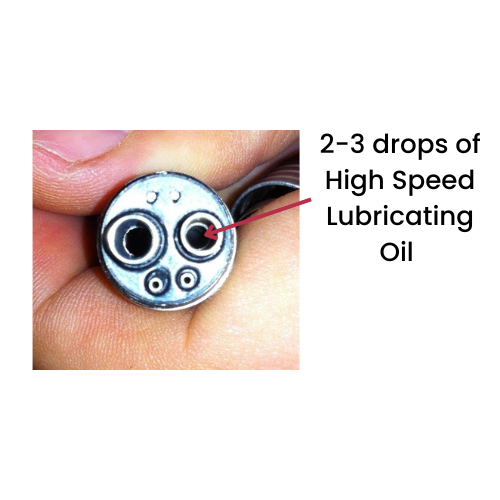Posted on: 30/01/2024, 09:00
Dental Handpiece Maintenance Guide - High Speed Turbine
Ensure the peak performance of your high-speed turbine dental handpiece with our comprehensive maintenance guide. Follow expert tips from the Technical Team at Vet Direct for optimal functionality and durability.
High Speed Turbine Hand piece
Before explaining the maintenance for a turbine hand piece, it is important to understand the operation of a high speed hand piece.
When a high speed hand piece is running, it exhausts air from the top and bottom of the head. However, when the user lifts off the foot switch the physics of the hand piece are altered, as the hand piece slows down - the turbine starts to aspirate material around the head and it will literally suck in debris including tooth dust, blood and other fine particles into the head of the hand piece.
Therefore, you can appreciate how dirty a turbine hand piece can become if the debris is not flushed out of the head prior to autoclaving. Failure to remove this debris will lead to an on-going process where the debris will bake around the turbine, resulting in premature failure of the hand piece, and possible damage to the dental unit itself.
After finishing each procedure the bur should be removed and discarded. The hand piece should then be rinsed under running water to remove any excessive debris or blood. It is also advisable to wipe the outside of the hand piece with suitable alcohol or disinfectant wipes and ideally autoclaved and re-oiled.
Human dentists use a fresh, fully cleaned and autoclaved hand piece between patients because of the huge risk of cross contamination of HIV. Vets should also consider cross contamination – particularly for FIV in cats. We would recommend that you should have 3 hand pieces (one in use, one in the autoclave and one cooling down ready for the next patient).
Oiling - The hand piece should be disconnected in accordance with the manufacturer’s guidelines.

The Air-Wave uses the popular 4-hole configuration. It is recommended to hold the hand piece down and rotate it so that the smaller holes/pins are closest to the body, then place 2-3 drops of lubricating oil into the smaller of the two larger holes on the right hand side, as shown in the diagram above. This should be carried out with a bur in situ, rotate the bur forwards and backwards to lubricate the mechanism fully. Reconnect the airline as recommended by the manufacturer and run for 6-10 seconds to remove any access oil before continuing with the work. The handpiece is to be oiled for every 15 minutes of running time!
If the hand piece is disassembled it should always be done using the correct spanner provided, not dental extraction forceps or pliers, as these will easily damage the fine screw threads of the head piece.
We would recommend having two high speed handpieces so that during long dental procedures they can be switched and oiled every 15 minutes.
Oil as above after autoclaving.
Oil all hand pieces as described earlier. It is advisable to bag the hand piece during autoclaving, to prevent oil being dispersed into the autoclave. If using half paper and half plastic bags then the paper side should be placed up over to aid evaporation.
After sterilising the hand piece they must be oiled again as previously described and left standing, to drain away any excess oil prior to next use. Note: The hand piece should be cool before oiling.
You now need to run each component for 6-10 seconds to remove excess oil.
REMEMBER THE FOUR GOLDEN RULES OF MAINTENANCE – CLEAN, LUBRICATE, RUN, STERILISE, LUBRICATE and RUN
High Speed Turbine Hand piece
Before explaining the maintenance for a turbine hand piece, it is important to understand the operation of a high speed hand piece.
When a high speed hand piece is running, it exhausts air from the top and bottom of the head. However, when the user lifts off the foot switch the physics of the hand piece are altered, as the hand piece slows down - the turbine starts to aspirate material around the head and it will literally suck in debris including tooth dust, blood and other fine particles into the head of the hand piece.
Therefore, you can appreciate how dirty a turbine hand piece can become if the debris is not flushed out of the head prior to autoclaving. Failure to remove this debris will lead to an on-going process where the debris will bake around the turbine, resulting in premature failure of the hand piece, and possible damage to the dental unit itself.
After finishing each procedure the bur should be removed and discarded. The hand piece should then be rinsed under running water to remove any excessive debris or blood. It is also advisable to wipe the outside of the hand piece with suitable alcohol or disinfectant wipes and ideally autoclaved and re-oiled.
Human dentists use a fresh, fully cleaned and autoclaved hand piece between patients because of the huge risk of cross contamination of HIV. Vets should also consider cross contamination – particularly for FIV in cats. We would recommend that you should have 3 hand pieces (one in use, one in the autoclave and one cooling down ready for the next patient).
Oiling - The hand piece should be disconnected in accordance with the manufacturer’s guidelines.

The Air-Wave uses the popular 4-hole configuration. It is recommended to hold the hand piece down and rotate it so that the smaller holes/pins are closest to the body, then place 2-3 drops of lubricating oil into the smaller of the two larger holes on the right hand side, as shown in the diagram above. This should be carried out with a bur in situ, rotate the bur forwards and backwards to lubricate the mechanism fully. Reconnect the airline as recommended by the manufacturer and run for 6-10 seconds to remove any access oil before continuing with the work. The handpiece is to be oiled for every 15 minutes of running time!
If the hand piece is disassembled it should always be done using the correct spanner provided, not dental extraction forceps or pliers, as these will easily damage the fine screw threads of the head piece.
We would recommend having two high speed handpieces so that during long dental procedures they can be switched and oiled every 15 minutes.
Oil as above after autoclaving.
Autoclaving
All the hand pieces are suitable for autoclaving, burs should always be removed.Oil all hand pieces as described earlier. It is advisable to bag the hand piece during autoclaving, to prevent oil being dispersed into the autoclave. If using half paper and half plastic bags then the paper side should be placed up over to aid evaporation.
After sterilising the hand piece they must be oiled again as previously described and left standing, to drain away any excess oil prior to next use. Note: The hand piece should be cool before oiling.
You now need to run each component for 6-10 seconds to remove excess oil.
REMEMBER THE FOUR GOLDEN RULES OF MAINTENANCE – CLEAN, LUBRICATE, RUN, STERILISE, LUBRICATE and RUN
Products You May Like






